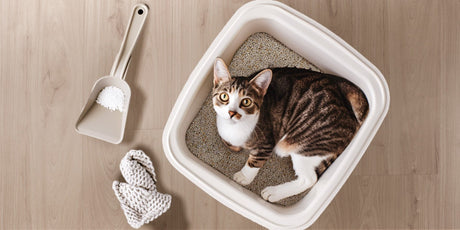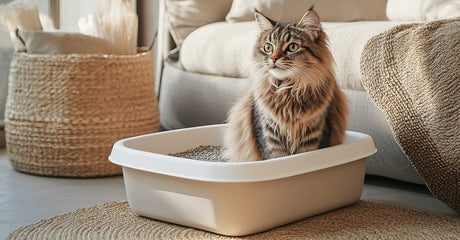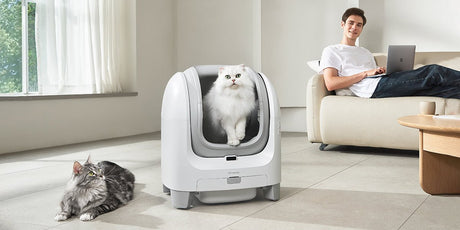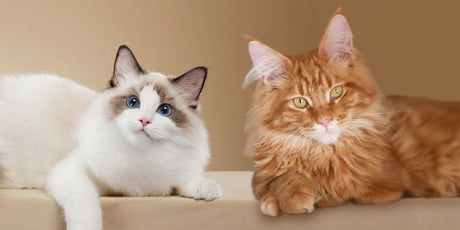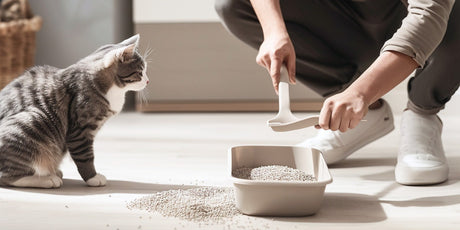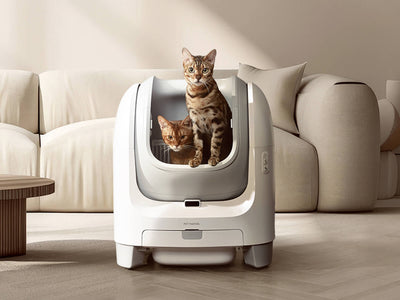Cat urine contains high concentrations of ammonia, and their waste releases sulfides and other harmful gases during decomposition. If you are particularly sensitive to smells or have respiratory conditions, you may experience nausea or even vomiting. A survey of cat owners showed that about 60% of users are troubled by odors when cleaning the litter box, with 15% experiencing physical discomfort (such as vomiting).
I have outlined the content of this article, which will incorporate relevant data to illustrate measures that pet owners need to understand and can improve to help reduce the likelihood and duration of such discomfort:
1. Choosing the right litter.
2. Cleaning the litter and litter box.
3. Selecting appropriate tools.
4. Maintaining a good environment and conditions.
Choosing the Right Litter
On January 2, 2025, our team gathered insights from the top 100 cat litters on amazon.com through smart reviews and summarized the following key points mentioned. Unsurprisingly, the primary requirement for cat litter is odor control! The second concerns are clumping ability and dust content. All three issues are closely related to the odor problem of cat litter.

At the same time, we obtained the main raw materials of common cat litter on Amazon from the internet, and combined with tools to gather the deodorizing data of cat litter primarily made from these materials as follows:

Based on the above data, and without considering other deodorizing factors added to the cat litter:

- From the perspective of deodorizing perception, we recommend the following list:
Mordenite Zeolite, Mixed, Silica Gel, Clay, Pine - Considering the prices of these cat litters on the market, we then recommend the following list:
Clay, Silica Gel, Mixed
Of course, during the specific purchasing process, you should also consider the deodorizing effects promoted by the seller and user reviews.
Note: For “Mixed,” it is necessary to specifically evaluate the types of mixed cat litter and deodorizing factors.
How often do you clean the cat litter and litter box?
According to our user behavior data research report, only 45% of users clean their cat litter boxes daily, 30% clean them every other day, and only 25% clean them once a week. In fact, when you search the internet about how often to clean them, you will find nearly uniform answers: clean the cat litter box 1-2 times a day, replace the litter once a week, and wash the litter box once every 1-2 weeks. This is because:
Residual urine and feces in the litter box can lead to rapid bacterial growth (such as E. coli and Salmonella). Male cats are more susceptible to infections due to their narrower urethra. Research shows that over 30% of cats with lower urinary tract diseases have poor litter box hygiene. The number of bacteria in an uncleaned litter box can increase to more than ten times the initial value within 24 hours (simulated experimental data), and the probability of infection increases by 3-5 times when a cat's external genitalia directly contacts contaminated litter during urination.
Additionally, urea in cat urine decomposes into ammonia within 48 hours, and when the concentration exceeds 50 ppm, it can irritate human respiratory mucosa. The ammonia concentration in a litter box that has not been cleaned for a week can reach 200 ppm (4 times above the safety threshold). Experiments show that cat litter mixed with urine and feces can detect mycotoxigenic mold, such as Aspergillus, within 7 days, and its spores may trigger allergic reactions in humans.


Use Suitable Tools
Choosing the right cat litter scoop, mask, gloves, and other cleaning tools can help speed up the scooping process, reduce direct contact with odors or bacteria, and significantly lessen your discomfort.
1. Cat Litter Scoop: Metal scoops are 40% faster at sifting litter compared to plastic scoops. In tests, cleaning 1L of clumping litter with a metal scoop took only 15 seconds, while a plastic scoop required 25 seconds. Cat litter scoops with large holes (> 5mm) can further improve sifting efficiency by 30%. A scoop of suitable size with an ergonomic handle reduces wrist strain, making the scooping task 50% easier.
2. Mask: If you are using low-dust litter such as crystal litter, a surgical mask can help filter out 80% of the dust. If you are using clay litter with more dust, an N95 mask is a great choice, as it has a filtration efficiency of ≥95% for 0.3μm particles, blocking more than 95% of dust and pathogens. If you are more concerned about odors, an activated carbon mask can reduce ammonia concentration by 50%-70%.

3. Gloves: Disposable nitrile gloves block 99.9% of bacteria (such as E. coli) and have better liquid permeability than latex gloves. If you are worried about the possibility of the litter containing Toxoplasma eggs, it is recommended to spray it with 75% alcohol before disposing of it.
4. Automatic Litter Box: If you have an automatic litter box that can scoop waste, control odors, and pack litter without contact (click here for details), you may not need any of the above tools. I understand that investing in an automatic litter box requires some funds, but it is definitely worth it. Assuming you scoop once a day, spending an average of 5 minutes each time, you would spend 30 hours a year on this task. Calculating at an hourly wage of $15, you would save $450 a year on this work.
 Create a Good Environment and Conditions
Create a Good Environment and Conditions
1. Good Ventilation: Placing the litter box near a window can increase odor dispersion efficiency by over 200%. A dry and cooler temperature helps slow down bacterial growth. You can also use a fan to achieve these conditions.
2. Use Air Fresheners or Deodorizers: Choose pet-safe deodorizing products, such as activated charcoal odor absorbers or natural air fresheners.
3. Avoid Scooping on an Empty Stomach or Right After Meals: This can significantly increase the likelihood of you feeling nauseous. Additionally, soothing music can help reduce the discomfort that scooping may cause you psychologically.

For more tips on deodorizing the litter box, readers can refer to my earlier article "25 Tips to Eliminate Odor of Cat Litter Box," which I hope will be as helpful as this one. If you have more tips, feel free to leave a comment below. I hope these tips and specific tools will help readers continuously optimize their cat care practices. Gradually, you will find that the warmth brought by having a cat far outweighs the daily inconveniences.


